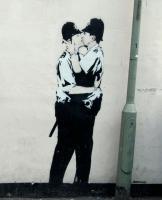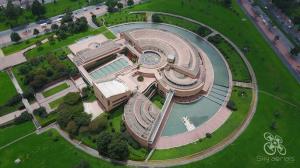9 works by Carlos Cruz-Diez and his plastic principles
Carlos Cruz-Diez (1923-2019) is a Venezuelan artist who became one of the most important exponents of the kinetic art or kinetic in the world. It was his research and proposals on chromaticism that gave him his particular tone. Let's get to know some of his works and the most important plastic principles of him.
Although he started out as a figurative artist, Cruz-Diez transitioned toward abstraction in the 1950s. Before coming up with his kinetic approaches, he worked on different investigations, especially between 1954 and 1959, the transition period.
The first of them would already have the germ of a social vocation. It was about the Mural projects, which involved faith in the democratization of art through the participatory, the playful and the public. This will be followed Parenchyma, Moving rhythmic objects and finally, Instability in plane, which brought him closer to his new path.
1. Black, white and red construction
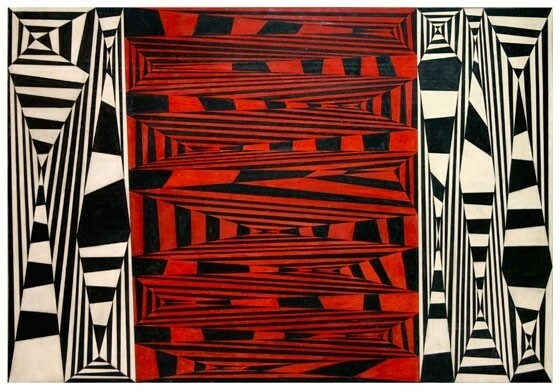
Of the cycle Instability in plane, we highlight the work Black, white and red construction, in which the elements of kineticism are already observed: the study of optical illusions through the decontextualization of geometric elements and color.
2. Couleur Additive. Series 32 One 4 ABD
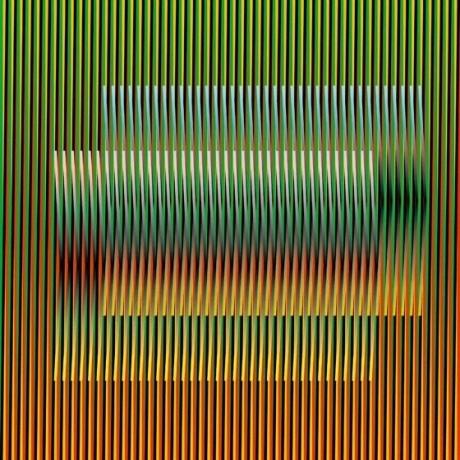
Around 1950, Cruz-Diez's research led him to propose in his works the principle of additive color (couleur additive), from which he elaborates a series that will accompany him throughout the years. In this, the artist works the concept of the irradiation of color, according to which, when two planes of color come into contact, the illusion of a darker line is formed. This was called by Cruz-Diez as “chromatic event modules”.
3. Physiochromia (Central bank of Venezuela)

Note that it is the same work from two different angles.
Physichromie or physiochromia It is a series that Carlos Cruz-Diez began to develop in 1959. As described on the artist's official website, it receives this name for "putting into play the light color, the physical color." This series works on structures in which the perception of color is modified by the viewer's movement in space and the incidence of ambient light.
4. Induction du Rouge

The chromatic induction (induction chromatique) is a concept based on the principle of retinal persistence, according to which, after fixing the gaze for a moment on a color, this remains in the retina and, when observing another surface of a different color, this is modified by the persistence of the previous. On this concept stands the work Induction du rouge.
5. Chrome interference environment
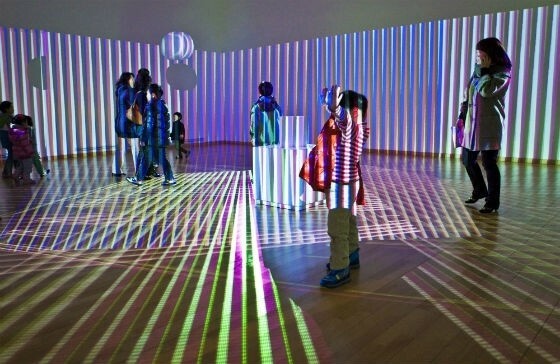
The Serie chrome interference (chromointerférence) was developed from 1964, when in his workshop the artist observed how the behavior of color was modified when crossing the frames of two moving plates.

From this, he moved on to compositions that included movement in themselves or that invited the viewer to literally go into the work to see the effect of the interference of color.
6. Transchromia at the Faena House
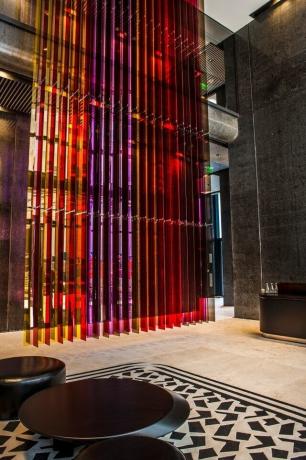
The principle of transchromia(transchromie) was explored by Cruz-Diez from about 1965. To develop it, the artist uses transparent colored plates. When light passes through them, it generates various lighting effects. Some of them can be manipulated by viewers, leading to new variations.
7. Chromosaturation chamber
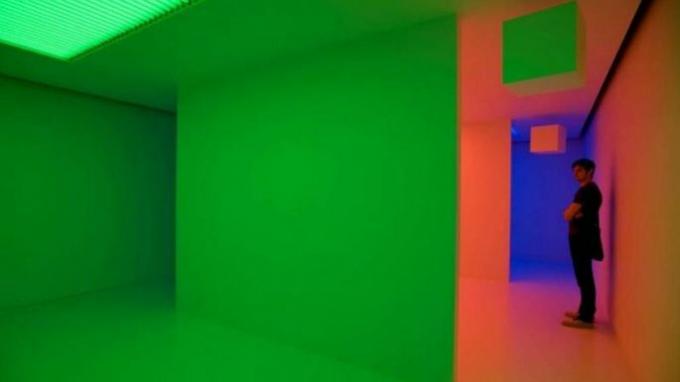
Another of the most interesting concepts that Cruz-Diez works can be seen in the series Chromosaturation (Chromosaturation). According to his official page, the chromosaturation It can be understood as "an artificial environment composed of three color cameras, one red, one green and one blue, which immerse the visitor in an absolute monochrome situation." This technique allows you to affect the modes of perception of color, making you perceive its materiality outside of a cultural context that affects the interpretation.
8. Couleur à l’Espace

In the series Couleur à l’Espace, Cruz-Diez isolates a line or a linear section within the set, to explore the different chromatic phenomena that occur in the viewer's gaze with its movement and the incidence of the light. This concept has been worked on from the 1990s.
9. The public art of Carlos Cruz-Diez
In addition to working on his theories on museum surfaces or in installations, Cruz-Diez's social vocation leads him to integrate his concepts aesthetics in everyday life, either through public art, or through its functional integration with the architectural space and urban.
There were many works that Carlos Cruz-Diez has left throughout the world, which makes him an artist of international influence, with an impeccable trajectory, which is incorporated into our daily landscapes leaving a beauty possible. In this section, we are going to inventory some of his most famous works of public art.
Simón Bolívar International Airport, Caracas, Venezuela
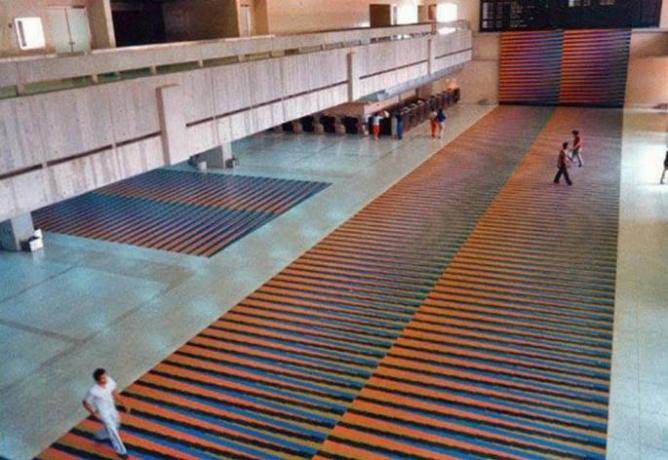
Chromostructure, Kenex Plaza building, Panama.
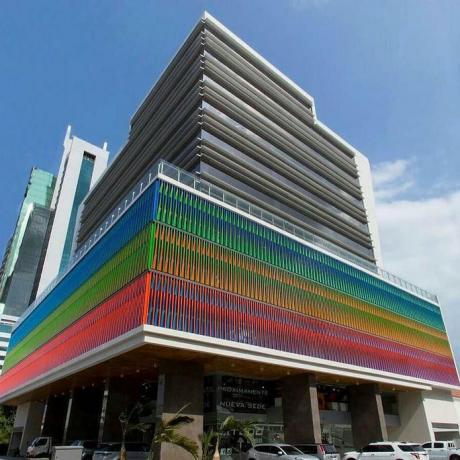
It may interest you: Kinetic art: most important characteristics and artists
Biography of Carlos Cruz-Diez

Carlos Cruz-Diez was born in Caracas on August 17, 1923 and passed away in Paris on July 27, 2019.
His initial studies were carried out at the School of Plastic and Applied Arts. Cruz-Diez began his career as an artist still linked to figurative art. The first professional works of him at the graphic level will be done in the publishing world in Venezuelan magazines and newspapers such as The National.
He later he will venture as a creative in an advertising agency. Towards the 1950s, the artist began a series of investigations that brought him closer and closer to abstraction, a path through which he arrived at the formulation of his particular kineticism.
In the 1960s he moved to the city of Paris, where he established his residence. Carlos Cruz-Diez develops a series of works throughout his life, based on specific plastic principles, always related to color and movement.
He participates in various group and solo exhibitions internationally. During a season, he serves as a teacher at the Superior School of Fine Arts and Kinetic Techniques of Paris and, shortly after, he also serves as Senior Lecturer at the International Institute for Advanced Study of Caracas.
In addition to a prolific and widely known artistic work, Cruz-Diez also published his theoretical reflections in the book Reflection on color, in which he presents the result of his research and experiments.
He has received important decorations, including:
- the Grand Prize, III American Biennial of Art, National University of Córdoba, Argentina (1966);
- the National Prize of Plastic Arts, Venezuela (1971);
- the Ordre National de la Légion d'Honneur, Official degree, France (2012) and
- the Páez Medal of the Arts, New York, United States (2012).


